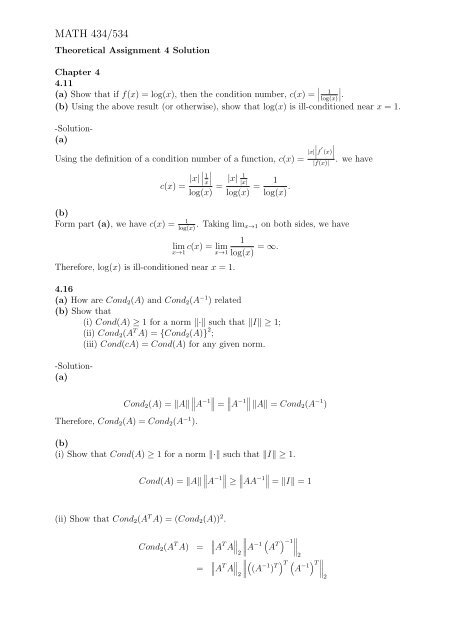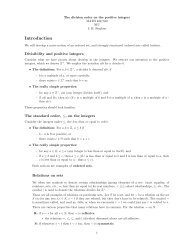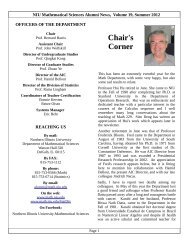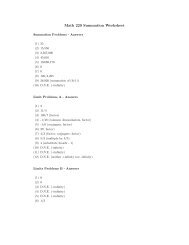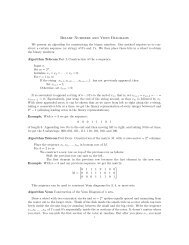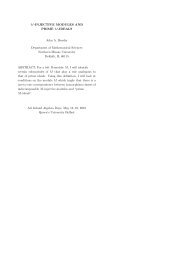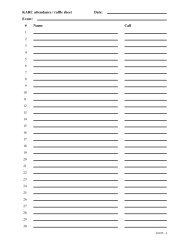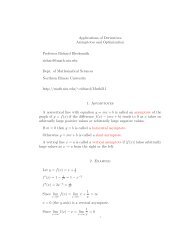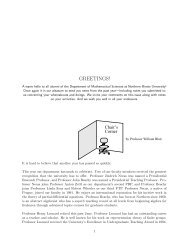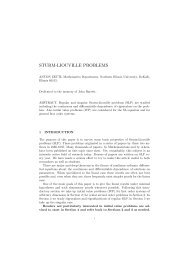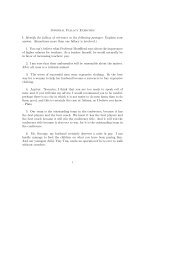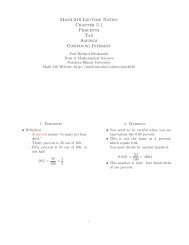MATH 434/534
MATH 434/534
MATH 434/534
You also want an ePaper? Increase the reach of your titles
YUMPU automatically turns print PDFs into web optimized ePapers that Google loves.
<strong>MATH</strong> <strong>434</strong>/<strong>534</strong><br />
Theoretical Assignment 4 Solution<br />
Chapter 4<br />
4.11<br />
(a) Show that if f(x) = log(x), then the condition number, c(x) = ∣ ∣<br />
1 ∣<br />
∣.<br />
log(x)<br />
(b) Using the above result (or otherwise), show that log(x) is ill-conditioned near x = 1.<br />
-Solution-<br />
(a)<br />
∣ ∣ ∣∣f<br />
Using the definition of a condition number of a function, c(x) = |x| ′ (x) ∣∣<br />
. we have<br />
|f(x)|<br />
∣ c(x) = |x| ∣∣ 1<br />
∣<br />
x<br />
log(x) = |x| 1<br />
|x|<br />
log(x) = 1<br />
log(x) .<br />
(b)<br />
Form part (a), we have c(x) = 1<br />
log(x) . Taking lim x→1 on both sides, we have<br />
1<br />
lim c(x) = lim<br />
x→1 x→1 log(x) = ∞.<br />
Therefore, log(x) is ill-conditioned near x = 1.<br />
4.16<br />
(a) How are Cond 2 (A) and Cond 2 (A −1 ) related<br />
(b) Show that<br />
(i) Cond(A) ≥ 1 for a norm ‖·‖ such that ‖I‖ ≥ 1;<br />
(ii) Cond 2 (A T A) = {Cond 2 (A)} 2 ;<br />
(iii) Cond(cA) = Cond(A) for any given norm.<br />
-Solution-<br />
(a)<br />
∥<br />
Cond 2 (A) = ‖A‖ ∥A −1∥ ∥<br />
∥ ∥∥A ∥ =<br />
−1 ∥ ‖A‖ = Cond2 (A −1 )<br />
Therefore, Cond 2 (A) = Cond 2 (A −1 ).<br />
(b)<br />
(i) Show that Cond(A) ≥ 1 for a norm ‖·‖ such that ‖I‖ ≥ 1.<br />
Cond(A) = ‖A‖ ∥ ∥ ∥A<br />
−1 ∥ ∥ ∥ ≥<br />
∥ ∥∥AA −1 ∥ ∥ ∥ = ‖I‖ = 1<br />
(ii) Show that Cond 2 (A T A) = (Cond 2 (A)) 2 .<br />
Cond 2 (A T A) =<br />
=<br />
∥<br />
∥<br />
∥A T ∥∥∥<br />
A∥ A ( −1 A ) ∥ T −1 ∥∥2<br />
2<br />
∥<br />
∥<br />
∥A T ∥∥∥ (<br />
A∥ (A −1 ) ) T T ( ∥ A −1) T ∥∥2<br />
2
Since ∥ ∥A T A ∥ ∥2 = ‖A‖ 2 2<br />
, we have<br />
However,<br />
Cond 2 (A T A) =<br />
∥<br />
∥A T ∥ ∥ ∥2 = ‖A‖ 2<br />
. Therefore, we have<br />
∥<br />
∥<br />
∥A T ∥∥∥ (<br />
A∥ (A −1 ) ) T T ( ∥ A −1) T ∥∥2<br />
2<br />
= ‖A‖ 2 ( ) ∥ 2 ∥ A<br />
−1<br />
T 2<br />
∥∥<br />
Cond 2 (A T A) = ‖A‖ 2 ∥<br />
∥<br />
2<br />
∥(A −1 ) T 2<br />
∥<br />
2<br />
= ‖A‖ 2 ∥<br />
2<br />
∥(A −1 ) ∥ 2<br />
∥<br />
2<br />
= { ‖A‖ 2<br />
∥ ∥∥(A −1 ) ∥ ∥ ∥2<br />
} 2<br />
= {Cond2 (A)} 2<br />
2<br />
(iii) Show that Cond(cA) = Cond(A) for any given norm.<br />
Cond(cA) = ‖cA‖ ∥ ∥ ∥(cA)<br />
−1 1<br />
∥ = |c| ‖A‖<br />
∥<br />
∥A −1∥ ∥ = Cond(A)<br />
|c|<br />
4.17<br />
(a) Let A be an orthogonal matrix. Then show that Cond 2 (A) = 1.<br />
(b) Show that Cond 2 (A) = 1 if and only if A is a scalar multiple of an orthogonal matrix.<br />
-Solution-<br />
(a)<br />
Since A is an orthogonal matrix, A T = A −1 . Now look at the Cond 2 (A). Letting ρ(A) be<br />
the maximum eigenvalue of A, we have<br />
∥ ∥∥A<br />
Cond 2 (A) = ‖A‖ ∥ −1 2 ∥2<br />
√ √<br />
= ρ(A T A) ρ ((A −1 ) T (A −1 ))<br />
Since A T = A −1 , A T A = A −1 A = I and A = (A −1 ) T . Therefore we have<br />
Cond 2 (A) =<br />
=<br />
=<br />
√ √<br />
ρ(A T A) ρ ((A −1 ) T (A −1 ))<br />
√ √<br />
ρ(I) ρ (A(A −1 ))<br />
√ √<br />
ρ(I) ρ (I)) = 1<br />
(b)<br />
First we will show that Cond 2 (A) = 1 if A is a scalar multiple of an orthogonal matrix.<br />
Let O be an orthogonal matrix and c be a scalar constant. Then, let A = cO and ρ(A) be<br />
the maximum eigenvalue of A. Then consider the Cond 2 (A)<br />
Cond 2 (A) = Cond 2 (cO)<br />
= Cond 2 (O)<br />
√<br />
√<br />
= ρ(O T O) = ρ(I) = 1<br />
2
Now suppose that Cond 2 (A) = 1. Then we will show A is a scalar multiple of an orthogonal<br />
matrix. From the singular value decomposition of A (Please read page 23 carefully), we have<br />
orthogonal matrices U ∈ R n×n and V ∈ R n×n<br />
A = UΣV T<br />
where Σ = diag(σ 1 , . . . , σ n ) ∈ R n×n and σ 1 ≥ σ 2 ≥ · · · ≥ σ n where σ i for i = 1, 2, . . . , n are<br />
called singular values of a matrix A.<br />
Now considering that Cond 2 (A) = 1, from “Some Properties of the Condition Number<br />
of Matrix” on page 67, we have<br />
1 = Cond 2 (A) = σ max<br />
σ min<br />
.<br />
This implies σ max = σ min . Therefore, we have σ max = σ 1 = σ 2 = · · · = σ n = σ min . Now let<br />
σ i = c for i = 1, 2, . . . , n. From A = UΣV T , we have<br />
⎛<br />
⎞<br />
c 0 · · · 0<br />
0 c · · · 0<br />
A = U<br />
⎜ .<br />
⎝ . . . ⎟<br />
. .<br />
V T<br />
⎠<br />
0 0 · · · c<br />
= cUIV T<br />
= cUV T .<br />
However, U and V T are orthogonal matrices. Letting O = UV T , we have A = cUV T = cO,<br />
where O is an orthogonal matrix because the product of orthogonal matrices is an orthogonal<br />
matrix.<br />
Therefore, Cond 2 (A) = 1 if and only if A is a scalar multiple of an orthogonal matrix.<br />
4.18<br />
Let U = (u ij ) be a nonsingular upper triangular matrix. Then show that<br />
Cond ∞ (U) ≥ max |u ii|<br />
min |u ii | .<br />
Hence construct a simple example of an ill conditioned nondiagonal symmetric positive definite<br />
matrix.<br />
-Solution-<br />
Let U be an n × n upper triangular matrix. First consider what U −1 looks like, especially<br />
its diagonal entries. Since U is an upper triangular matrix, U −1 is also an upper triangular<br />
matrix. Now letting<br />
⎛<br />
⎞<br />
⎛<br />
⎞<br />
a 11 a 12 · · · a 1n<br />
b 11 b 12 · · · b 1n<br />
0 a<br />
U =<br />
22<br />
.. . a2n<br />
⎜ .<br />
and U −1 0 b<br />
=<br />
22<br />
.. . b2n<br />
⎝ . . .. ⎟<br />
⎜ .<br />
,<br />
. ⎠<br />
⎝ . . .. ⎟ . ⎠<br />
0 · · · 0 a nn 0 · · · 0 b nn<br />
we have<br />
⎛<br />
⎞<br />
a 11 b 11 ∗ · · · ∗<br />
. I = UU −1 0 a<br />
=<br />
22 b 22 . . .<br />
⎜ .<br />
⎝ . .. .<br />
.<br />
.. ⎟ ∗ ⎠<br />
0 · · · 0 a nn b nn<br />
3
Therefore, we can see that b ii = 1<br />
a ii<br />
. By the definition of a maximum row-sum norm ‖·‖ ∞<br />
,<br />
that is, ‖A‖ ∞<br />
= max 1≤i≤m<br />
∑ nj=1<br />
|a ij |, we have<br />
‖U‖ ∞<br />
≥ max |u ii |<br />
and<br />
∥<br />
∥U −1∥ ∥ ∥∞ ≥<br />
1<br />
min |u ii | .<br />
Take<br />
U =<br />
⎛<br />
⎜<br />
⎝<br />
0.0001 2 3<br />
0 1 12<br />
0 0 12<br />
⎞<br />
⎟<br />
⎠<br />
Then Cond(U) = 4.9025 × 10 5 .<br />
4.19<br />
Let A = LDL T be a symmetric positive definite matrix where L is a unit lower triangular<br />
matrix. Let D = diag(d ii ). Then show that<br />
Cond 2 (A) ≥ max(d ii)<br />
min(d ii ) .<br />
Hence construct an example for an ill-conditioned nondiagonal symmetric positive definite<br />
matrix.<br />
-Solution-<br />
Since A = LDL T is a symmetric positive definite matrix and L is a lower triangular matrix,<br />
we have the diagonal entries of a diagonal matrix, d ii > 0 for i = 1, 2, . . . , n. Therefore, we<br />
have<br />
A = LDL ⎛<br />
T<br />
⎞ ⎛<br />
1 0 0<br />
= ⎜<br />
⎝ ∗ . .. ⎟ ⎜<br />
0 ⎠ ⎝<br />
∗ ∗ 1<br />
⎞ ⎛<br />
d 11 0 0 1 ∗ ∗<br />
. 0 . . ⎟ ⎜<br />
0 ⎠ ⎝ 0 . .. ∗<br />
0 0 d nn 0 0 1<br />
⎞<br />
⎟<br />
⎠<br />
where d ii > 0 for i = 1, 2, . . . , n.<br />
Since d ii > 0 for i = 1, 2, . . . , n, we have<br />
A = LDL T = ( LD 1 2<br />
) (<br />
D<br />
1<br />
2 L<br />
T ) = ( D 1 2 L<br />
) (<br />
D<br />
1<br />
2 L<br />
) T<br />
where D 1 2<br />
have<br />
= diag( √ d 11 , √ d 22 , . . . , √ d nn ). Let a lower triangular matrix ̂L = LD 1 2 . Then we<br />
A = LDL T<br />
= ( D 1 2 L<br />
) (<br />
D<br />
1<br />
2 L<br />
) T<br />
=<br />
̂L ̂L<br />
T<br />
Now consider Cond 2 (A). Using Cond 2 (A T A) = {Cond 2 (A)} 2 , we have<br />
Cond 2 (A) = Cond 2 ( ̂L ̂L T )<br />
= { Cond 2 ( ̂L T ) } 2<br />
· · · (∗)<br />
4
Now look at only Cond 2 ( ̂L T ).<br />
Cond 2 ( ̂L T ) = ∥ ∥ ̂L ̂L ∥ ∥ T ∥∥∥ (<br />
∥2 ̂L ̂L ) ∥ T −1 ∥∥2<br />
(<br />
=<br />
∥ ̂L ) T T ( ̂L )∥ ∥ T ∥ ∥∥∥∥ { (<br />
∥∥2 ̂L −1) T } T ( ̂L −1) T<br />
∥ 2<br />
= ∥ ̂L ∥ T 2<br />
( ∥<br />
∥ 2 ∥ ̂L −1) T 2<br />
∥∥ = ∥ ∥ ̂L ∥ 2<br />
∥ ∥ ̂L −1∥ ∥2<br />
· · · (∗∗)<br />
2 2 2<br />
Now consider ∥ ̂L<br />
∥ and ∥ ̂L −1∥ ∥ ∥2 .<br />
2<br />
Using the standard basis e i = (0, 0, . . . , 0, 1, 0, 0, . . . , 0), and the definition of matrix norms<br />
} {{ }<br />
i−1 zeros<br />
‖A‖ p<br />
= max ‖x‖p =1 ‖Ax‖ p<br />
, we have<br />
∥ ̂L ∥ ∥2 = max ∥ ̂Le<br />
∥ √<br />
∥∥2 i = max d ii<br />
‖x‖ 2 =1<br />
Since the diagonal entries of ̂L −1 are the reciprocal of the diagonal entries of ̂L, it can be<br />
expressed as 1<br />
d ii<br />
for i = 1, 2, . . . , n. Therefore, we have<br />
∥ ̂L −1∥ ∥ ∥2 = max ∥ ̂L<br />
∥ −1 ∥∥2<br />
e i = max 1 1<br />
√ =<br />
‖x‖ 2 =1<br />
dii min √ d ii<br />
From (∗∗), we have<br />
Cond 2 ( ̂L T ) =<br />
( ) ( ) 2 2<br />
1<br />
max<br />
√d ii<br />
min √ d ii<br />
= max(d ii)<br />
min(d ii )<br />
From (∗) and (∗ ∗ ∗), since max(d ii)<br />
min(d ii<br />
, now we have<br />
)<br />
Therefore, we have<br />
Cond 2 (A) = { Cond 2 ( ̂L T ) } 2<br />
=<br />
· · · (∗ ∗ ∗)<br />
( ) 2<br />
max(dii )<br />
≥ max(d ii)<br />
min(d ii ) min(d ii ) .<br />
Cond 2 (A) ≥ max(d ii)<br />
min(d ii ) .<br />
The Hilbert matrix is a symmetric positive definite. However, it is known as an ill-conditioned<br />
matrix.<br />
4.20<br />
Prove that for a given norm, Cond(AB) ≤ Cond(A)Cond(B)<br />
-Solution-<br />
Cond(AB) = ‖(AB)‖ ∥ ∥ ∥(AB)<br />
−1 ∥<br />
≤ ‖A‖ ‖B‖ ∥ ∥ ∥<br />
∥A<br />
−1 ∥ ∥∥B ∥ −1 ∥<br />
= ‖A‖ ∥ ∥ ∥<br />
∥A<br />
−1 ∥ ‖B‖ ∥∥B ∥ −1 ∥ = Cond(A) · Cond(B)<br />
Therefore, Cond(AB) ≤ Cond(A) · Cond(B).<br />
5


